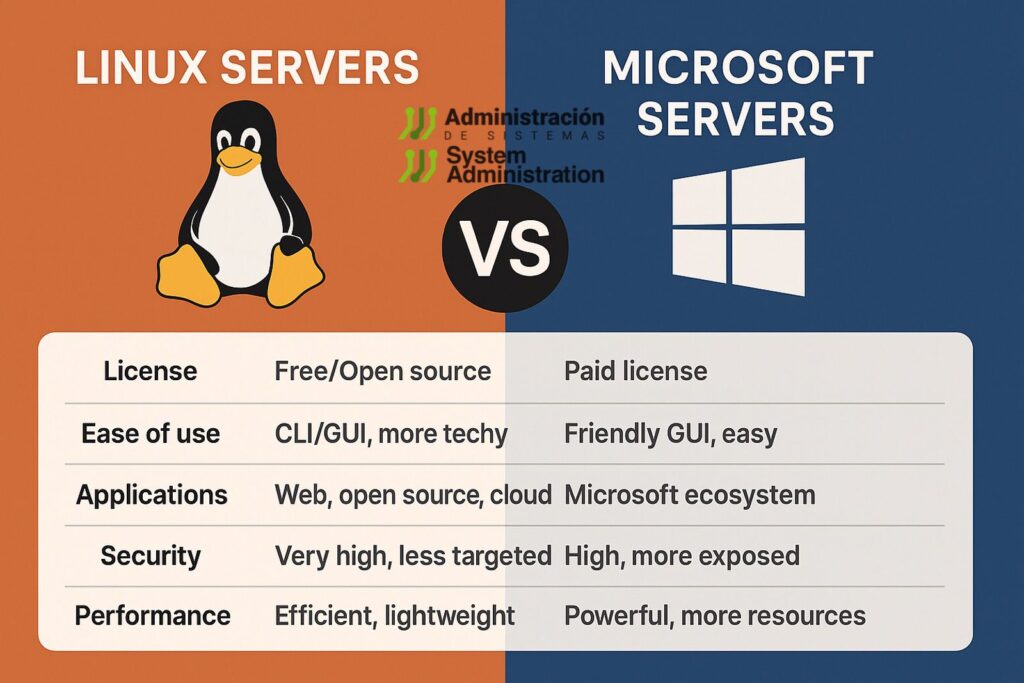In the business and IT infrastructure world, choosing between Linux servers and Microsoft servers (Windows Server) remains one of the most strategic and debated decisions. Both operating systems have evolved to offer security, performance, and flexibility, but they present fundamental differences that can determine the success of a company or technology project.
1. Licensing and Costs
Linux Servers:
Linux stands out for being open source and, in most of its distributions (such as Ubuntu Server, CentOS, Debian, or AlmaLinux), completely free. You only have to pay for support if you opt for commercial distributions like Red Hat Enterprise Linux (RHEL) or SUSE Linux Enterprise, which offer professional support and guaranteed updates.
Microsoft Servers:
Windows Server requires purchasing licenses for the operating system itself and for each user or device (CALs: Client Access Licenses). This results in a higher initial investment and recurring costs depending on scaling needs and support.
Summary:
- Linux: Free or low support cost.
- Windows: Licensing, CALs, and renewal costs.
2. Ease of Administration and Learning Curve
Linux Servers:
Historically, Linux was considered more complex, aimed at advanced users or system administrators familiar with the command line. Today, tools like Cockpit, Webmin, or graphical interfaces for basic tasks have made the curve easier. However, advanced administration is still based on scripts, configuration files, and the terminal.
Microsoft Servers:
Windows Server offers a graphical user interface (GUI) familiar to desktop Windows users, making tasks like user management, roles, policies, and services easier through wizards and dashboards. PowerShell has gained prominence for automation, but the environment remains less intimidating for average users.
Summary:
- Linux: Greater flexibility, ideal for advanced automation, but requires more technical expertise.
- Windows: More intuitive for users without UNIX/Linux experience.
3. Compatibility and Application Ecosystem
Linux Servers:
Linux is the foundation for most web servers (Apache, Nginx), open source databases (MySQL, PostgreSQL, MariaDB), and modern development applications (Docker containers, Kubernetes, CI/CD). It is the preferred option for cloud deployments and DevOps environments.
Microsoft Servers:
Windows Server integrates perfectly with the Microsoft ecosystem: Active Directory, Exchange, SQL Server, SharePoint, and is essential for organizations relying on legacy Windows applications or proprietary solutions. Support for .NET and enterprise applications is a strong point.
Summary:
- Linux: Leader in web, cloud, open source, and agile development.
- Windows: Recommended for Microsoft environments and traditional enterprise apps.
4. Security
Linux Servers:
The UNIX permissions philosophy and an active community make Linux highly secure. Vulnerabilities are usually patched quickly thanks to code transparency and rapid global collaboration. Tools like SELinux, AppArmor, or advanced firewalls provide extra protection.
Microsoft Servers:
Windows Server has improved considerably in recent versions (with Windows Defender, BitLocker, role isolation, automatic updates, etc.). However, due to its historic popularity, it still faces more malware and attack attempts.
Summary:
- Linux: Strong security, less targeted by mass attacks.
- Windows: Advanced security, but with a historically higher exposure to threats.
5. Performance and Scalability
Linux Servers:
Linux is famous for its efficiency, low resource consumption, and ability to run on modest or older hardware. Its modularity allows installing only what is needed, optimizing performance—key for high-traffic servers or microservices.
Microsoft Servers:
Windows Server has improved significantly in resource management and scalability (especially since Windows Server 2016), but requires more resources by default and can have more overhead due to the graphical interface and bundled services.
Summary:
- Linux: More efficient and lightweight, ideal for virtualization and large deployments.
- Windows: Solid in large enterprise environments, but with higher hardware requirements.
6. Support and Community
Linux Servers:
Linux’s global community is one of its greatest assets. Forums, documentation, wikis, and the availability of commercial support (Red Hat, SUSE, Canonical) ensure that help is always available. It’s also easy to find solutions for nearly any technical issue.
Microsoft Servers:
Windows Server has professional support from Microsoft, a vast knowledge base, official training, and an active community. It’s essential for companies that require SLA support and contractual guarantees.
Summary:
- Linux: Large community, optional professional support.
- Windows: Robust official support, ideal for large corporations.
7. Updates and Lifecycle
Linux Servers:
Updates can be automatic or managed manually depending on the distribution. LTS (Long Term Support) cycles of Ubuntu, Debian, or RHEL make planning easier. Many distros allow updates without rebooting.
Microsoft Servers:
Updates are centralized and automatic but often require reboots. Lifecycles are well defined, with extended support for enterprise versions, providing predictability.
Quick Comparison Table
| Feature | Linux Servers | Microsoft Servers |
|---|---|---|
| License | Free/Open source | Paid license |
| Ease of use | CLI/GUI, more techy | Friendly GUI, easy |
| Applications | Web, open source, cloud | Microsoft ecosystem |
| Security | Very high, less targeted | High, more exposed |
| Performance | Efficient, lightweight | Powerful, more resources |
| Support | Community/commercial | Official Microsoft |
| Updates | Flexible, no reboot | Centralized, reboot |
Conclusion: Which One to Choose?
The decision between Linux and Microsoft servers should be based on business requirements, critical applications, budget, and the technical team’s experience. Linux is unbeatable in flexibility, cost, and performance for modern infrastructures and DevOps projects, while Windows Server is the logical choice for organizations fully integrated into the Microsoft ecosystem and requiring direct corporate support.
Both systems have proven their robustness and reliability, and the current trend is for many companies to use both in hybrid strategies, combining the best of each world.

